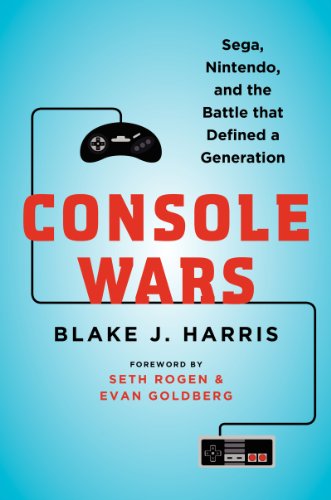Console Wars (the book) might be better than the very games that fueled the fire
 For any male readers born from the mid ’70s to early ’80s, listen up—Console Wars by Blake Harris has it all: your childhood, the answer to your next marketing challenge, cultural divides, innocence, under bellies, triumph, and loss.
For any male readers born from the mid ’70s to early ’80s, listen up—Console Wars by Blake Harris has it all: your childhood, the answer to your next marketing challenge, cultural divides, innocence, under bellies, triumph, and loss.
It’s also the only book I’ve ever read that made me feel as young as I am old. Take these gems, for example:
- “There was no such thing as a magic touch, and it wouldn’t have mattered if there were, because the only thing it takes to sell toys, vitamins, magazines (or anything) is the power of story. That was the secret. That was the whole trick: to recognize that the world is nothing but chaos, and the only thing holding it (and us) together are stories… When you tell memorable, universal, intricate, and heartbreaking stories, anything is possible.”
- “Tony Harman was prepared to leave with his tail between his legs (smiling, though, as his thesis that western cultures can make great games too had made it all the way to the top), but he decided to try one more approach. “Let me just ask one more question,” he said, taking a step toward [Nintendo President] Yamauchi. “How many bad television commercials do we make each year?” Yamauchi burst out in laughter. “The answer: many.” Harman nodded. “And how much does each one of these commercials cost you?” Yamauchi quickly discussed this with the experts on his couches and then came back with an answer. “They say around $3 million.” Harman nodded once again. “Then why don’t you give me $3 million and one year to make a great game? Maybe I’m wrong and won’t succeed with this, but the worst-case scenario is that you’ll just make one less bad commercial.” At this, Yamauchi smiled, the finest and most silvery smile Harman had ever seen, and then the legendary president of Nintendo stood up and accepted the deal.” The game Harman went on to make: Donkey Kong Country, a record-selling and console war shifting “reminder that there were always breakthroughs to be made with what existed already.”
- “The [Japanese] were highly talented and certainly not lazy, but deep down they weren’t as interested in winning as they were in not losing,” which explains why Sega largely failed in Japan but succeeded in risk-taking America, according to most Americans interviewed in the book.
- “Video games weren’t just for kids; they were for anyone who wanted to feel like a kid.”
- “Just like Disney and Mickey Mouse, Nintendo and Mario were uncool in exactly the same way: because they weren’t supposed to be cool. They were supposed to be fun, timeless, and magical, and with those great strengths came the great weakness of appealing to teens and young adults.”
- “Sega was no longer the alternative upstart, but just the new giant ready to fall, the way Nintendo and Atari had before them. Sega CD, 32X, and the Sega Channel would be viewed not as dynamic innovations but as flops that took Sega’s attention away from the oncoming freight train” that was the Sony PlayStation.
At 550 pages, the book is about 50 pages too long. But for any of my ’90s contemporaries, I highly recommend it. Four stars out of five. Bonus points for naming my favorite city of residence: “Up until this point, the Mariners’s equipment had been sitting in Provo, Utah, where drivers awaited instructions on whether they should drive to Seattle or Milwaukee.”
